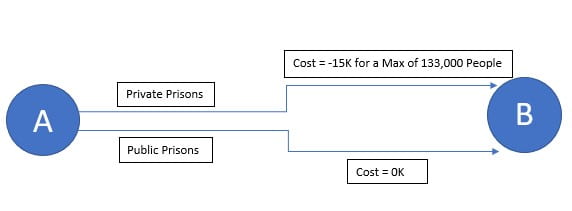Private Prisons vs. Public Prisons and its Application in Networks
The discussion surrounding the morality of privately owned prisons has been a highlighted discussion point in modern politics. Controversy surrounds private prisons due to companies profiting off housing inmates whose living conditions are significantly lower than public government prisons. Private prisons are able to make profit by cutting prison staff which accounts for over 70% of prison expenses and paying staff a much lower salary with less benefits. Additionally cuts are made on maintenance aspects of these prisons.
In the paper “Private and Public Sector Prisons—A Comparison of Select Characteristics” by Curtis Blakely of the University of South Alabama and Vic Bumphus of the University of Tennessee Chattanooga statistics on the operation of public and private prisons are analyzed. Findings showed that private prisons paid $0.38 less for average hourly wage, had double the inmate on inmate violence, had a staff salary difference of almost $15,000, had an average of 58 less hours of training, and an average staff turnover rate approaching 3 times the rate of public prisons. Although there were some areas where private prisons performed better than public prisons the difference between the two performances were not significant.
2.3 million people are incarcerated in the U.S. today with private prisons accounting for approximately 133,000. Once a person is convicted the government must decide whether they should serve their sentence in a private or public prison. This can be modeled in a similar way to the networks we discussed in class that minimized travel time from one node to another. In this scenario the cost of each edge is the cost of housing one prisoner per year.
Government Perspective:
The government saves on average $10,000 per year per inmate when sending a person to a private prison opposed to a public one. Thus the ideal strategy to minimize costs is to send as many prisoners to private prisons as possible.
Private Prison Perspective:
*Note that a negative cost means that the prison makes money
Private prisons make on average $15,000 dollars more per prisoner per year when a person is sent to a private prison opposed to a public prison. Thus the ideal strategy to maximize profits is to have as many people as possible in private prisons.
It is beneficial for both the government and private prison companies to maximize the number of people sent to private prisons. The government and public prisons benefit by having its costs cut and the private prisons benefit by making a profit.
The networks above show how the issue stems from the government and private prison companies working together to maximize the number of prisoners sent to private prisons with subpar living conditions and many other issues. Many private prisons in their contract with the government have terms that if the private prison is not above a certain occupancy percentage they will still be compensated for the prisoners that are not there. This further incentives the government to send more people to private prisons.
It is interesting to note that the ideal strategy is best economically, but this strategy is not the best ethically. This is why the issue of private prisons and the inhumane conditions of some facilities needs to be addressed with urgency and the only way to address this is to educate more people and encourage others to voice their opinions. It can be seen that private prisons are beneficial to both parties and change will not happen unless it is demanded.
Sources:
https://www.uscourts.gov/sites/default/files/68_1_5_0.pdf
https://www.sentencingproject.org/publications/private-prisons-united-states/
https://www.investopedia.com/articles/investing/062215/business-model-private-prisons.asp


